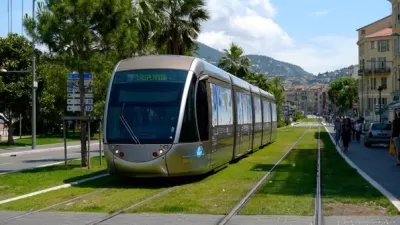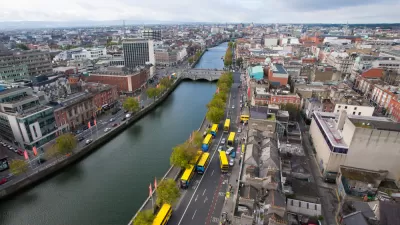Chuck Wolfe suggests three, perhaps non-traditional ideas for how to inspire acceptance of change in our cities through accessible experiences.

Writing in The Huffington Post, Chuck Wolfe provides three suggestions for advancing civic dialogue about evolving cities.
He begins with an evocative photo of the Nice, France tramway--a city-center transit line which has helped to transform a former automobile-oriented downtown, arguing:
Immersion in the real look and feel (and sometimes sound and smell) of a more compact and sustainable local experience can feed arguments for change, justify expenditures or tell how to cast a strategic election vote. Personal involvement is the most powerful and verifiable way to champion the city cause, over and above mere acceptance of empirical data, article prose and illustrations.
But how best, he asks, to inspire others' personal preferences for cities when an in-person visit to an inspirational place is not possible? How do we translate in real terms the popular arguments in favor of urban density and moderated use of the automobile?
Based on his prior writing, advocacy and research experience, Wolfe suggests and illustrates three methods to bring innovative messages home in a meaningful way:
- By example, in order to create personal meaning from an abstract goal.
- By gestalt, and the value of a surprise event that recalls something well-known.
- By local reinvention, including firsthand observation that is closer to home, where local action can supplement big ideas through demonstrable implementation.
While photographs, artwork, numbers and the written word are accessible to most, in my view, limited access to real-time experience of place is a challenge to urbanist sermons and rankings. I find that successful advocacy and implementation is more about facilitating real and personal commitment in others than in proselytizing about the abstract, and for that, we need more accessible experiences.
FULL STORY: Three Everyday Ways to Inspire Urban Change

Study: Maui’s Plan to Convert Vacation Rentals to Long-Term Housing Could Cause Nearly $1 Billion Economic Loss
The plan would reduce visitor accommodation by 25,% resulting in 1,900 jobs lost.

North Texas Transit Leaders Tout Benefits of TOD for Growing Region
At a summit focused on transit-oriented development, policymakers discussed how North Texas’ expanded light rail system can serve as a tool for economic growth.

Why Should We Subsidize Public Transportation?
Many public transit agencies face financial stress due to rising costs, declining fare revenue, and declining subsidies. Transit advocates must provide a strong business case for increasing public transit funding.

How to Make US Trains Faster
Changes to boarding platforms and a switch to electric trains could improve U.S. passenger rail service without the added cost of high-speed rail.

Columbia’s Revitalized ‘Loop’ Is a Hub for Local Entrepreneurs
A focus on small businesses is helping a commercial corridor in Columbia, Missouri thrive.

Invasive Insect Threatens Minnesota’s Ash Forests
The Emerald Ash Borer is a rapidly spreading invasive pest threatening Minnesota’s ash trees, and homeowners are encouraged to plant diverse replacement species, avoid moving ash firewood, and monitor for signs of infestation.
Urban Design for Planners 1: Software Tools
This six-course series explores essential urban design concepts using open source software and equips planners with the tools they need to participate fully in the urban design process.
Planning for Universal Design
Learn the tools for implementing Universal Design in planning regulations.
City of Santa Clarita
Ascent Environmental
Institute for Housing and Urban Development Studies (IHS)
City of Grandview
Harvard GSD Executive Education
Toledo-Lucas County Plan Commissions
Salt Lake City
NYU Wagner Graduate School of Public Service



























